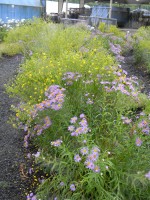Celebration and Transition
By SPP Project Manager Kelli Bush
 The Sustainable Prisons Project (SPP) recently celebrated another year with our many wonderful partners. The event, held on a cool summer evening at the Olympia Farmer’s Market, featured a wide range of guest speakers representing various aspects of the Sustainable Prisons Project. Speakers from Department of Corrections, Joint Base Lewis McChord, The Evergreen State College (TESC), Center for Natural Land Management, Washington Department of Fish and Wildlife, and a prison volunteer each spoke about the significance of SPP from their perspective.
The Sustainable Prisons Project (SPP) recently celebrated another year with our many wonderful partners. The event, held on a cool summer evening at the Olympia Farmer’s Market, featured a wide range of guest speakers representing various aspects of the Sustainable Prisons Project. Speakers from Department of Corrections, Joint Base Lewis McChord, The Evergreen State College (TESC), Center for Natural Land Management, Washington Department of Fish and Wildlife, and a prison volunteer each spoke about the significance of SPP from their perspective.
The event was also an opportunity to honor out-going Co-Director and Co-Founder of the SPP, Dr. Nalini Nadkarni. Nalini has accepted a position at University of Utah as the Director of the Center for Science and Math Education. She will remain involved with SPP as Senior Advisor. Nalini is also continuing work to share SPP with other states, including at her new location in Utah.
 We also welcomed new SPP Co-Director Dr. Carri LeRoy. Carri began working with the SPP team in April and she officially began her new role as SPP Co-Director July 1st. She is a stream ecologist and a member of the Masters of Environmental Studies faculty at Evergreen. Carri is an excellent addition to the team and we look forward to continuing the Project with her leadership.
We also welcomed new SPP Co-Director Dr. Carri LeRoy. Carri began working with the SPP team in April and she officially began her new role as SPP Co-Director July 1st. She is a stream ecologist and a member of the Masters of Environmental Studies faculty at Evergreen. Carri is an excellent addition to the team and we look forward to continuing the Project with her leadership.
After a year filled with declining budgets we are extremely grateful to our partners, students, TESC staff, foundations, and grant funding sources that helped keep this project going. We are excited to see what the next year brings!
To donate to the SPP and help bring conservation into Washington prisons, click here.




































